The turning red of mung beans after cooking is mainly related to the oxidation of polyphenols in the mung bean skin, which is a normal phenomenon. Green bean skin contains abundant polyphenol oxidase and anthocyanins, which react with minerals in water during high-temperature cooking, causing the color to gradually change from green to reddish brown. This phenomenon does not affect food safety, but the degree of discoloration may be exacerbated by factors such as water quality acidity, cooking time, or container material. Green beans are more prone to turning red in alkaline water because the alkaline environment accelerates the oxidation reaction of polyphenolic substances. The water quality in northern regions is generally hard and weakly alkaline, and the color change is more pronounced when cooking mung bean soup. Using an iron pot or boiling it open for a long time can also promote oxidation and deepen the color of the soup. If mung beans are stored for a long time, the antioxidant components in the skin will decrease, and the probability of discoloration after cooking will be higher. Some varieties have thicker skins or higher anthocyanin content, and their color changes more significantly after cooking. Fresh mung beans usually have a lighter degree of discoloration due to their intact skin structure. If you want to keep the soup green, you can use pure water to quickly stew and avoid using metal tools to stir. The red mung bean soup still retains most of its nutrients, such as dietary fiber and potassium, but some thermosensitive vitamins may be lost due to oxidation.

When cooking mung beans in daily life, there is no need to pay too much attention to color changes, as turning red does not affect its heat clearing and cooling effects. It is recommended to refrigerate the cooked mung bean soup in a timely manner to reduce oxidation. For those with spleen and stomach deficiency and cold, a small amount of ginger can be added to balance the cold nature. If pursuing visual aesthetics, mung beans can be soaked in water in advance and quickly blanched to remove some polyphenol oxidase before formal cooking. Reasonable combination of ingredients such as Job's tears and lilies can not only enrich the taste but also reduce the degree of oxidation and discoloration.










Comments (0)
Leave a Comment
No comments yet
Be the first to share your thoughts!